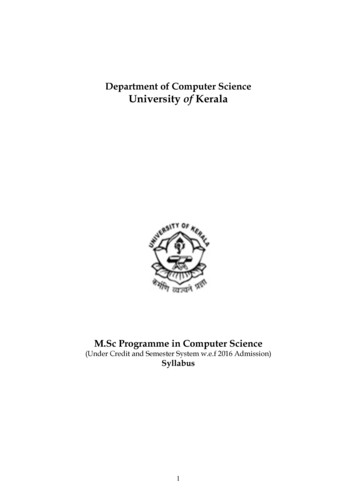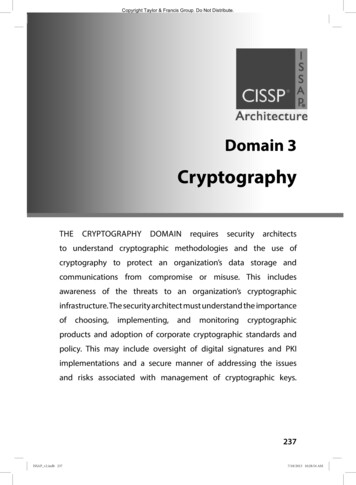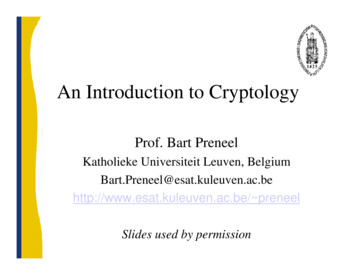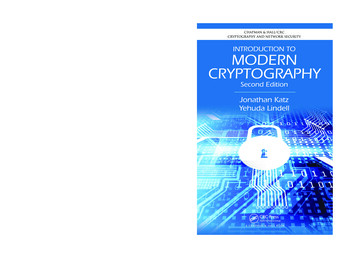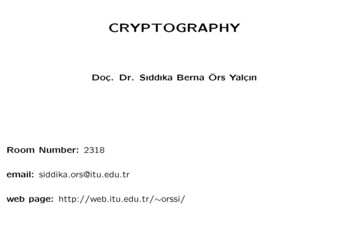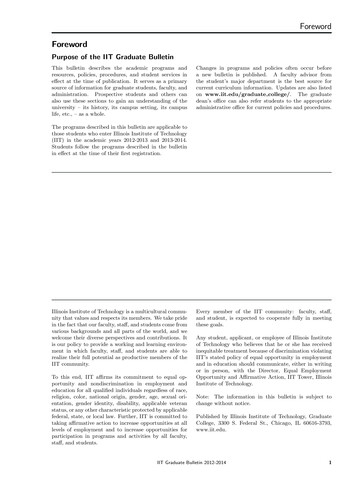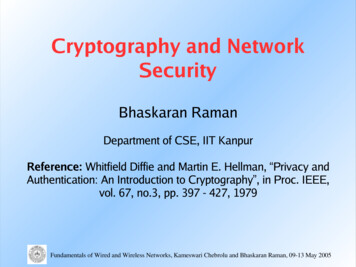
Transcription
Cryptography and NetworkSecurityBhaskaran RamanDepartment of CSE, IIT KanpurReference: Whitfield Diffie and Martin E. Hellman, “ Privacy andAuthentication: An Introduction to Cryptography” , in Proc. IEEE,vol. 67, no.3, pp. 397 - 427, 1979Fundamentals of Wired and Wireless Networks, Kameswari Chebrolu and Bhaskaran Raman, 09 13 May 2005
Cryptography Fundamentals Privacy versus Authentication:–Privacy: preventing third party from snooping–Authentication: preventing imposteringTwo kinds of authentication:–Guarantee that no third party has modified data–Receiver can prove that only the senderoriginated the data Digital Signature E.g., for electronic transactionsFundamentals of Wired and Wireless Networks, Kameswari Chebrolu and Bhaskaran Raman, 09 13 May 2005
Cryptographic PrivacyEavesdropperSenderPEncryptionC SK(P) Key: KReceiverC S 1K(P)Terms: plain text and cipher textTwo components: key, and the algorithm–Should algorithm be secret? NetworkDecryptionPEncrypt before sending, decrypt on receiving– CYes, for military systems; no, for commercial systemsKey distribution must be secureFundamentals of Wired and Wireless Networks, Kameswari Chebrolu and Bhaskaran Raman, 09 13 May 2005
Cryptographic AuthenticationEavesdropperSenderPC'EncryptionC SK(P) NetworkKey: KDecryptionP'ReceiverC' S 1K(P')The same system can also be used forauthenticationFundamentals of Wired and Wireless Networks, Kameswari Chebrolu and Bhaskaran Raman, 09 13 May 2005
Cryptanalysis Cryptanalysis: attacker tries to break the system–E.g., by guessing the plain text for a given cipher text–Or, by guessing the cipher text for some plain textPossible attacks:–Cipher-text only attack–Known plain-text attack–Chosen plain-text attack–Chosen text attackFundamentals of Wired and Wireless Networks, Kameswari Chebrolu and Bhaskaran Raman, 09 13 May 2005
Security Guarantees Two possibilities:–Unconditional–Computational securityUnconditional security: an example– One-time tapeMost systems have computational security–How much security to have?–Depends on cost-benefit analysis for attackerFundamentals of Wired and Wireless Networks, Kameswari Chebrolu and Bhaskaran Raman, 09 13 May 2005
Public-Key Systems Shared-key difficulties in key distribution– C(n,2) O(n 2) keysPublic key system–Public component and a private component–Two kinds: –Public key distribution: establish shared key firstPublic key cryptography: use public/private keys inencryption/decryptionPublic key cryptography can also be used fordigital signaturesFundamentals of Wired and Wireless Networks, Kameswari Chebrolu and Bhaskaran Raman, 09 13 May 2005
Some Example Systems Permuted alphabet (common puzzle)–Can be attacked using frequency analysis,patterns, digrams, trigrams–Attack becomes difficult if alphabet size is large Transposition Poly-alphabetic: periodic or running key Codes versus ciphering–Codes are stronger, and also achieve datacompressionFundamentals of Wired and Wireless Networks, Kameswari Chebrolu and Bhaskaran Raman, 09 13 May 2005
Some Popular Systems Private key systems:– DES, 3DESPublic key systems:–RSA: based on difficulty of factoring–Galois-Field (GF) system: based on difficulty offinding logarithm–Based on knapsack problemFundamentals of Wired and Wireless Networks, Kameswari Chebrolu and Bhaskaran Raman, 09 13 May 2005
Digital Encryption Standard(DES)64 bits Plain textPR164 bits64 bitsKeyCipher textR2R16P 1Permutation, 16 rounds of identical operation, inverse permutationLi 1Each round uses adifferent 48 bit keyKi (from K) and aRi 1Li 1Ri 1combiner function FFKi Fundamentals of Wired and Wireless Networks, Kameswari Chebrolu and Bhaskaran Raman, 09 13 May 2005
Triple-DES (3DES) DES can be broken with 2 55 tries:–4500 years on an Alpha workstation–But only 6 months with 9000 AlphasTriple-DES:–Use DES thrice, with 3 separate keys, or withtwo keys (K1 first, then K2, then K1 again)Fundamentals of Wired and Wireless Networks, Kameswari Chebrolu and Bhaskaran Raman, 09 13 May 2005
Rivest, Shamir, Adleman (RSA)Public-Key Crypto-System Based on the fact that finding large (e.g. 100digit) prime numbers is easy, but factoringthe product of two such numbers appearscomputationally infeasibleChoose very large prime numbers P and Q–N PxQ–N is public; P, Q are secretEuler totient: Phi(N) (P-1)(Q-1) Numberof integers less than N & relatively prime to NFundamentals of Wired and Wireless Networks, Kameswari Chebrolu and Bhaskaran Raman, 09 13 May 2005
RSA (continued) Next, choose E in [2, Phi(N)-1], E is publicA message is represented as a sequenceM1, M2, M3., where each M in [0, N-1]Encryption: C ME mod NUsing the secret Phi(N), A can compute Dsuch that ED 1 mod Phi(N) ED k x Phi(N) 1 Then, for any X N, Xk x Phi(N) 1 X mod NFundamentals of Wired and Wireless Networks, Kameswari Chebrolu and Bhaskaran Raman, 09 13 May 2005
RSA (Continued) Decryption: CD MED Mk x Phi(N) 1 M mod N Example: Choose P 17, Q 31–N 527, Phi(N) 480–Choose E 7, then D 343–If M 2, Encryption: C 128–Decryption: D CD mod N 128343 mod 527 2Fundamentals of Wired and Wireless Networks, Kameswari Chebrolu and Bhaskaran Raman, 09 13 May 2005
Taxonomy of Ciphers Block ciphers: divide plain text into blocksand encrypt each independentlyProperties required:–No bit of plain text should appear directly incipher text–Changing even one bit in plain text should resultin huge (50%) change in cipher text–Exact opposite of properties required forsystematic error correction codesStream cipher: encryption depends oncurrent stateFundamentals of Wired and Wireless Networks, Kameswari Chebrolu and Bhaskaran Raman, 09 13 May 2005
Key Management Keys need to be generated periodically–New users–Some keys may be compromisedAddressing the O(n 2) problem with keydistribution–Link encryption–Key Distribution Centre (KDC): all eggs in onebasket–Multiple KDCs: better securityKey management easier in public keycryptographyFundamentals of Wired and Wireless Networks, Kameswari Chebrolu and Bhaskaran Raman, 09 13 May 2005
Some Non-Crypto Attacks Man-in-the-middle attack: play a trick bybeing in the middleTraffic analysis:–Can learn information by just looking atpresence/absence of traffic, or its volume–Can be countered using data paddingPlayback or replay attacks:–To counter: need to verify timeliness of messagefrom sender while authenticating–Beware of issues of time synchronizationFundamentals of Wired and Wireless Networks, Kameswari Chebrolu and Bhaskaran Raman, 09 13 May 2005
Fundamentals of Wired and Wireless Networks, Kameswari Chebrolu and Bhaskaran Raman, 09 13 May 2005 Public-Key Systems Shared-key difficulties in key distribution - C(n,2) O(n 2) keys Public key system - Public component and a private component - Two kinds: Public key distribution: establish shared key first Public key cryptography: use public/private keys in

